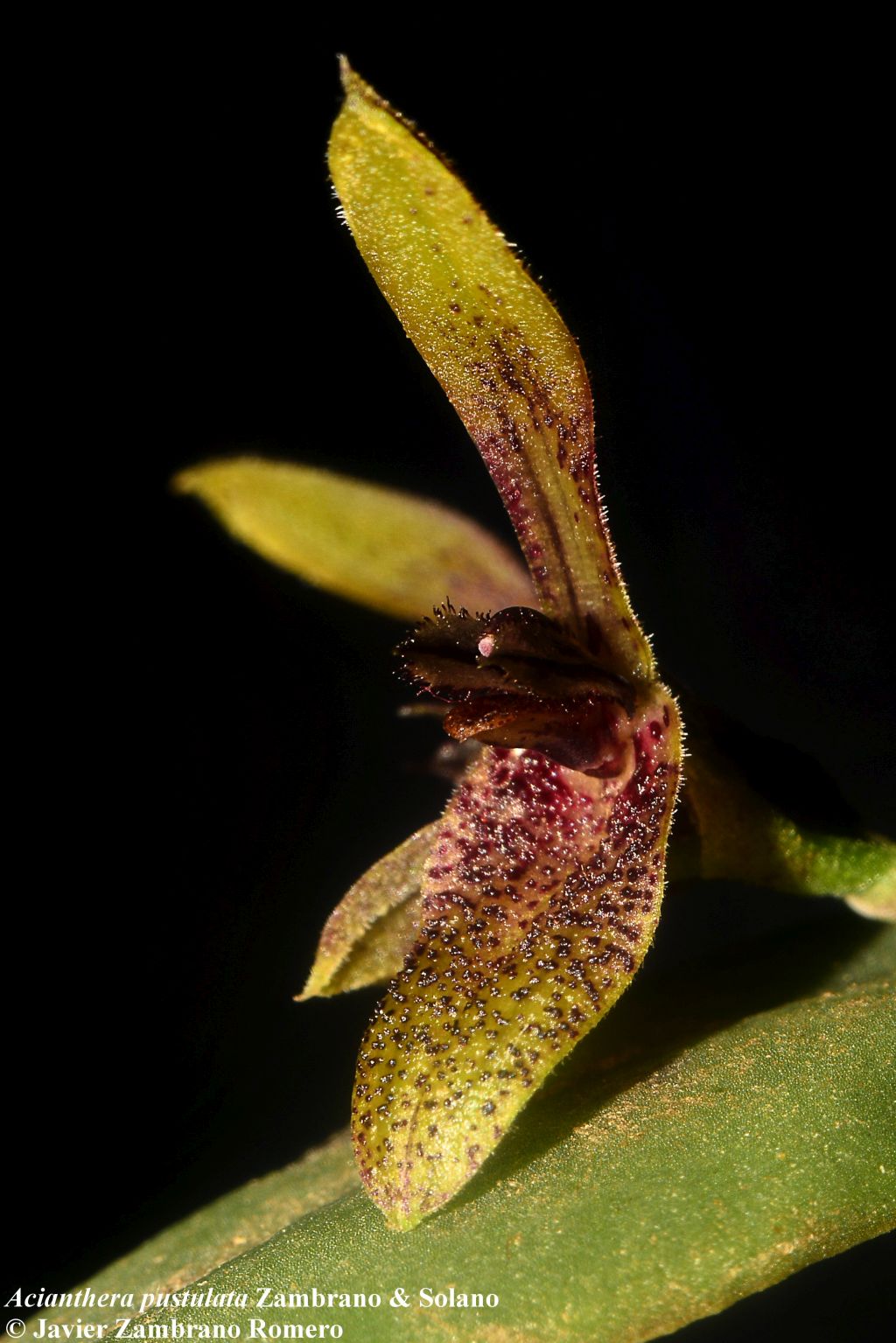

Pleurothallis pustulata [Zambrano & Solano] in ed.
SUBGENUS Acianthera [Scheidw.] Luer 1986
Photo by © Javier Zambrano Romero

 MID
MID  THROUGH EARLIER
THROUGH EARLIER 
Common Name The Pustulate Pleurothallis [refers to the abaxial surface of the sepals]
Flower Size .2” [5 mm]
Found in El Oro province of Ecuador in evergreen premontane and semi-deciduous premontane forests at elevations around 600 to 650 meters as a miniature sized, warm growing, caespitose epiphyte with pendent, terete at the base but then laterally compressed upward, slightly arching, channeled, ramicaul subtended by 2, tubular, imbricate, persistent, chartaceous sheaths and carrying a single, apical pendent, fleshy, coriaceous, elliptic-lanceolate, obtuse, emarginate-mucronate at the apex, slightly channeled below into the sessile base leaf that blooms in the mid summer through earlier spring on a shorter than the leaf, arising from the apex of the secondary stems, arising through a conduplicate, persistent, chartaceous spathe, peduncle terete, .4 to .56” [10 to 14 mm] long, minutely pubescent, covered at the base by 2 to 3 tubular, acute-acuminate, persistent, conduplicate, scarious bracts, rachis terete, .08 to .12” [2 to 3 mm] long, successively few flowered inflorescence with acute, minutely pubescent, persistent, scarious, longer than the pedicel floral bracts and carrying pendent, bilabiate, small flowers.
”Acianthera pustulata is a species that has been confused with P. quadriserrata (Luer) Pridgeon & Chase, another Ecuadorian endemic, apparently because both species are similar in having plants with pendent habit and aristate and serrate petals. The new taxon is similar to P. geminicaulina, P. juxtaposita, and P. lanceana. The most similar species is P. lanceana, but it is differs in the erect habit with terete secondary stems (vs. pendent habit with laterally compressed secondary stems), inflorescence longer than the leaf (vs. shorter than the leaf), glabrous sepals on abaxial surface (vs. pustulate), 3-nerved petals without a longitudinal callus (vs. 1-nerved, with a longitudinal and thick callus), oblong-trilobed, papillose lip with minutely serrate margins and a verrucose calli (vs. elliptic, rugose, entire, with a glabrous calli), and a dentate column (vs. winged at the apex). Another similar species is P. geminicaulina, which differs in its repent habit (vs. pendent and caespitose), marginally entire sepals (vs. ciliate), elliptic-obovate petals without a longitudinal callus (vs. oblong-elliptic, with a longitudinal and thick callus), and an elliptic-oblong, verrucose lip without glenion (vs. elliptic, rugose, with a glenion near the base). Finally, P. juxtaposita differs by its smaller and repent habit (1.4” vs 5.6” [3.5 cm vs. 14 cm]), pendent, ovate leaves (vs. elliptic-lanceolate), minutely pubescent ovary (vs. pubescent), entire lateral sepals (vs. ciliate), the apicules of the synsepal parallel to each other (vs. divergent to each other), obovate, denticulate, 3-nerved petals without a longitudinal callus (vs. oblong-elliptic, ciliate, 1-nerved and thick callus), and an oblong lip without glenion (vs. elliptic, with a viscous glenion near the base).” Zambrano & Solano 2019
Synonyms *Acianthera pustulata Zambrano & Solano 2019
References W3 Tropicos, Kew Monocot list , IPNI ;
* Phytotaxa 422: 256 Zambrano & Solano 2019 drawing/photo fide
--------------------------------------------------------------------------------------------------------------------------